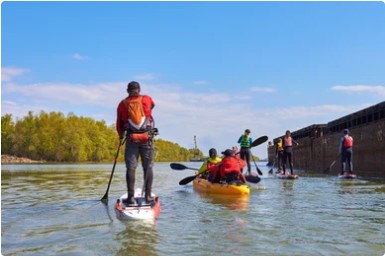Trying to dress for kayaking based on both the weather temperature and the water temperature can be a challenge. Learn a few recommendations on how to dress to each occasion.

Warm weather & warm water:
If you live in a hot part of the world that has warm water, dressing for kayaking is simple. Your biggest challenge will be staying cool, hydrated, and protected from the sun, and this should be something that you’re used to doing. The simplest solution involves using sunscreen and wearing a hat. Sunglasses are also helpful because the glare off the water can be blinding, and you’ll want to use some type of retainer strap, so you don’t lose them. Of course, the best way to protect yourself from the sun is to cover up, so you might want to wear a light long-sleeved shirt. Below the waist, surf shorts and water shoes or sandal like Teva work great.
Warm weather & cold water:
Dressing for cold water is far more difficult, especially when the air is warm. Even on the hottest days, if you find yourself swimming, the cold water can suck the heat out of your body at a surprising speed. If you’re paddling a sit-on-top kayak, you must expect that your lower body is going to be wet, whereas a sit inside kayak will protect you a lot more from both the wind and the water. On the other hand, if you flip when paddling a sit on-top kayak, you can just climb back on the boat. But if you flip a sit-inside, it will take you a lot longer to get back on board, which means you’ll spend more time in the cold water
Cold air & cold water:
When both the water and air temperature are cold, you must be aware of the threat of hypothermia and understand that paddling in these types of conditions isn’t for everyone. But if you are going to hit the water, you need to use clothing that will keep you warm, even when they are wet.
Fabric:
Synthetic fabric like fleece, neoprene, and polypropylene are good for this reason, and it’s best to use a couple of thinner layers instead of one thick layer. Wool also works well although it’s slow to dry and heavy when it’s wet. Cotton is one of the all-time worst materials to wear when it’s cold. Cotton draws heat from your body when it’s wet.
Paddling tops/bottoms:
Over top, you’ll want to have an outer shell that keeps the wind off your body. A waterproof nylon jacket and pants will do the trick, but at your local outdoor or paddling shop, you’ll find paddling tops and paddling bottoms that are designed specifically for the purpose. On your feet, neoprene booties and socks will help keep your toes warm.
Dry Suits:
The ultimate protection against the cold, though, is the dry suit. A dry suit uses latex gaskets at the ankle, wrists, and at the neck, which keeps all the water out. Dry suits are expensive, but if you spend a lot of time paddling in cold conditions, they are well worth the price.
Spray skirts:
If you’re using a sit-inside kayak you can also use a spray skirt, which keeps the cold water out and keeps the hot air in. When you’re putting on a spray skirt, you want to start along the back and work your way up along the coaming, then pull the skirt over the front coaming, making sure you leave the rip cord out, because that’s what you’re going to pull to pop the spray skirt if you do end up flipping.
Advice for Hazardous temperature:
If you add the water temperature and air temperature and the sum is less than 100, there is a cold hazard to paddling.



